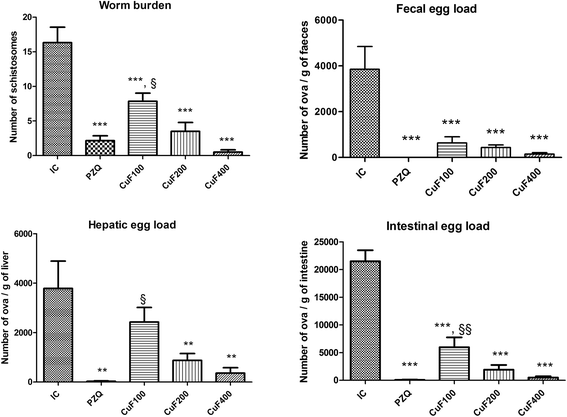Schistosomicidal, hepatoprotective and antioxidant activities of the methanolic fraction from Clerodendrum umbellatum Poir leaves aqueous extract in Schistosoma mansoni infection in mice
- PMID: 26205948
- PMCID: PMC4513613
- DOI: 10.1186/s12906-015-0788-z
Schistosomicidal, hepatoprotective and antioxidant activities of the methanolic fraction from Clerodendrum umbellatum Poir leaves aqueous extract in Schistosoma mansoni infection in mice
Abstract
Background: The intensive use of Praziquantel for the treatment of schistosomiasis has raised concerns about the possible emergence of drug-resistant schistosomes. As drug treatment is an important feature of schistosome control programs, the search for alternative drugs is therefore a priority. The aim of this study was to assess the schistosomicidal, hepatoprotective and antioxidant activities of the methanolic fraction from Clerodendrum umbellatum Poir leaves aqueous extract.
Methods: A phytochemical screening of the fraction of C. umbellatum was conducted. The fraction was administered orally and daily to Schistosoma mansoni-infected mice (BALB/c) from the 36th day post-infection for 28 days at 100, 200 and 400 mg/kg. Praziquantel (500 mg/kg) was used as reference drug. Non-infected and infected-untreated mice served as controls. All mice were sacrificed at 65th day post-infection. Body weight, liver/body and spleen/body weights, as well as worm burden, fecal egg count, liver and intestine egg load were determined. In the plasma, levels of total protein, transaminases (ALT, AST), alkaline phosphatase and total bilirubin were monitored to assess the possibility of liver damage. Malondialdehyde (MDA), catalase (CAT) and glutathione (GSH) levels were measured in the liver as biomarkers of the oxidative stress.
Results: The phytochemical analysis of the fraction from C. umbellatum aqueous leaves extract revealed the presence of alkaloids, flavonoids, cardiac glycosides, phenols, saponins, tannins and terpenoids. The worm burden, fecal egg count and egg load in the liver and intestine of infected mice treated with the fraction were significantly (p < 0.001) fewer than in infected-untreated mice. Only the highest-fraction dose reduced the worm and egg burdens in a similar way as praziquantel. Hepatosplenomegaly induced by S. mansoni infection was reduced by the treatment. The liver function on infected mice was ameliorate after administration of the fraction by significant reduction of ALT activity (35.43 to 45.25%) and increase of total protein level (44.79 to 70.03%). The methanolic fraction of C. umbellatum prevents the elevated MDA level induced by the infection while significant increase in catalase activity (297.09 to 438.98%) and glutathione level (58.23 to 95.88%) were observed after treatment.
Conclusions: This study disclosed the schistosomicidal, hepatoprotective and antioxidant activities of the methanolic fraction from C. umbellatum leaves aqueous. These fraction's activities were similar to those of praziquantel. This fraction can be considered as a promising source for schistosomicidal agents.
Figures


References
Publication types
MeSH terms
Substances
LinkOut - more resources
Full Text Sources
Other Literature Sources
Medical
Research Materials
Miscellaneous

